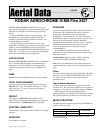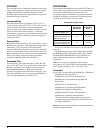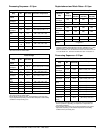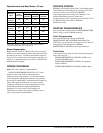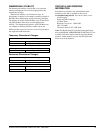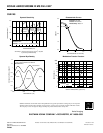
2 KODAK AEROCHROME III MS Film 2427 • AS-2569
STORAGE
For consistent results, all aerial films should be stored under
fairly constant conditions. Kodak aerial films are “usually”
packaged in equilibrium with 40 to 50 percent relative
humidity. High temperatures or high humidity may produce
undesirable changes in the film.
Unexposed Film
Store unexposed film in a refrigerator at 55°F (13°C) or
lower, or freezer at 0 to -10°F (-18to-23°C), in the original
sealed container. If the film is stored in a refrigerator,
remove it about 2 hours before opening; if stored in a freezer,
remove it about 8 hours before opening. A sufficient
warm-up time is necessary to prevent moisture condensation
on cold film– otherwise, moisture spotting, ferrotyping, or
sticking may occur.
Exposed Film
Keep exposed film cool and dry. Process the film as soon as
possible after exposure to avoid undesirable changes in the
latent image. If it is necessary to hold exposed but
unprocessed film for several days (such as over a weekend),
it should be resealed and refrigerated at 40°F (4°C) or lower.
Before unsealing and processing exposed film that has been
held in cold storage, follow the warm-up procedures
described for unexposed film described above.
Processed Film
For best keeping, store processed film in a dark, dust-free
area at 50 to 70°F (10 to 21°C) and 30 to 50 percent relative
humidity. Preferably, store negatives on the spool or in
individual KODAK Sleeves. High relative humidity
promotes the growth of mold and causes ferrotyping. Very
low relative humidity causes excessive curl and brittleness.
Avoid storage temperatures over 80°F(27°C).
PROCESSING
The primary recommendation for processing 2427 Film is in
Process AR-5 using mechanized processors. Mechanized
processing in roller-transport processors offers the
advantages of uniform treatment of all portions of the roll,
freedom from banding, and absence of significant density
variations from ends of the roll to the center.
Process AR-5 Cycle Times
In each case, the film is fed emulsion side down into the
processor.
This publication provides general information regarding
the KODAK Aerial Color Processor, Mode 1611, and the
KODAK EKTACHROME RT Processor, Model 1811.
Refer to the operating manuals for additional set-up
information.
Note: For a list of firms equipped to offer machine
processing of 2427 Film, write to Eastman Kodak Company,
Aerial Imaging, Rochester, New York 14653-7128.
Chemicals
Process AR-5 uses the following KODAK EA-5 Chemicals:
KODAK EA-5 First Developer *
KODAK EA-5 First Developer Replenisher
KODAK EA-5 First and Second Stop Bath and
Replenisher
KODAK EA-5 Color Developer
KODAK EA-5 Color Developer Replenisher
KODAK EA-5 Bleach and Replenisher
KODAK Aerial Color Fixer and Replenisher
KODAK EA-5 Stabilizer and Replenisher
The first developer working solution is prepared by
combining one part first developer with two parts first
developer replenisher.
Notice: Observe precautionary information on product labels and on
the Material Safety Data Sheets.
Processor Transport
Speed (feet
per minute)
Dry-to-Dry
Processing
Time
KODAK Aerial Color
Processor, Model 1611
3.5 17.4 min
KODAK EKTACHROME
RT Processor, Model 1811
(with Quick-Change)
3.5 17.2 min
KODAK EKTACHROME
RT Processor, Model 1811
(Standard Configuration)
5.3 13.6 min



